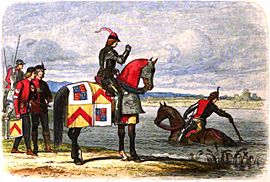Buckingham's rebellion facts for kids
Quick facts for kids Buckingham's rebellion |
|||||||
|---|---|---|---|---|---|---|---|
| Part of the Wars of the Roses | |||||||
|
|||||||
| Belligerents | |||||||
Supported by: |
|||||||
| Commanders and leaders | |||||||
The Buckingham's Rebellion was a major uprising in October 1483. It happened in England and parts of Wales. This rebellion was against Richard III of England, who had recently become king.
The main leader of this uprising was Henry Stafford, 2nd Duke of Buckingham. He had become unhappy with King Richard. The rebellion also had support from Henry Tudor, who was living in exile, and his mother, Margaret Beaufort. Many people who had been loyal to the previous king, Edward IV, and his son, Edward V, joined the rebels.
Henry Tudor planned to sail from Brittany (a region in France) with soldiers and his supporters. They hoped to start their own uprising at the same time. However, a big storm stopped their ships from landing. Meanwhile, a part of the rebellion in Kent started too early. This warned King Richard that Buckingham had switched sides.
Why the Rebellion Started
When King Edward IV died in April 1483, his brother, Richard of Gloucester, was chosen to protect the kingdom for Edward's young son, Edward V. Edward V was only 12 years old. Richard escorted the young king to the Tower of London. Edward's younger brother, Richard of Shrewsbury, joined him there.
Plans were made for Edward V's coronation. But before he could be crowned, his parents' marriage was declared invalid. This meant Edward V and his brother were no longer considered rightful heirs to the throne. On June 26, 1483, Richard III became king. He was crowned on July 6. After August, the young princes were not seen in public again. Rumours began that they had been murdered on Richard's orders. This led to the famous story of the Princes in the Tower.
In late September 1483, a secret plan began among unhappy nobles and landowners. Many of them had been loyal to Edward IV. This plan was led by the Duke of Buckingham, who had been an ally of Richard. It's thought that at first, they wanted to put Edward V back on the throne. But when rumours spread that the princes were dead, Buckingham suggested that Henry Tudor should return from exile. The plan was for Henry to become king and marry Elizabeth of York, who was the older sister of the princes.
Henry Tudor's claim to the throne came from his mother, Margaret Beaufort. She was related to the House of Lancaster. Henry had spent much of his life in exile. His mother, Margaret Beaufort, always worked to promote her son's right to the crown.
The Secret Plan Unfolds
The rebels planned to gather their forces in different parts of England and march towards London. Buckingham was to lead an army from Wales to join other rebel groups. Henry Tudor was supposed to bring an army of 3,500 soldiers from Brittany. He had the support of Pierre Landais, the treasurer of Brittany. Landais hoped that Buckingham's victory would create a strong alliance between Brittany and England.
However, the rebellion in Kent started about 10 days earlier than planned. This revealed Buckingham's involvement to King Richard. Richard acted quickly. He appointed a new officer, Ralph de Ashton, to arrest and punish the rebels. The Duke of Norfolk moved 100 men to block rebel forces from joining up. Richard also offered large rewards for the capture of rebel leaders, especially Buckingham.
Meanwhile, a big storm hit Henry Tudor's ships. Many of his ships had to return to Brittany or Normandy. Henry himself managed to anchor off Plymouth, but he was met by King Richard's supporters. He had to flee back to Brittany. There, he learned that Buckingham's part of the rebellion had failed.
Buckingham had gathered a large force from his lands in Wales. But his army was also affected by the same storm. They couldn't connect with other rebel groups and many soldiers left when Richard's forces approached. King Richard quickly defeated the rebellion in just a few weeks.

Buckingham tried to escape by disguising himself. But he was soon found and captured. He was found guilty of treason (betraying the king) and was beheaded in Salisbury on November 2.
What Happened Next
Even though Buckingham's rebellion completely failed in military terms, it had a big effect. It made many people think differently about Richard as king. Over the next few months, many important figures joined Henry Tudor's side. About 500 Englishmen escaped Richard's grasp and went to Rennes, the capital of Brittany. There, they formed an alliance with Henry Tudor.
The failure of this revolt did not end the plots against King Richard. He could never feel truly safe after this. Richard tried to make a deal with Pierre Landais in Brittany. He offered military help for Landais's ruler, Duke Francis II, in exchange for Henry Tudor. But Henry fled to Paris. In Paris, he got support from the French regent, Anne of Beaujeu. She provided troops for an invasion in 1485.
Henry Tudor also gained the support of the Woodville family, who were related to the late King Edward IV. He sailed with a small French and Scottish army. They landed in Pembrokeshire, Wales, near his birthplace, on August 7, 1485. Henry Tudor's forces fought and defeated King Richard at the battle of Bosworth Field on August 22. Richard was killed in the battle. Henry Tudor then became the new king of England, known as Henry VII.

